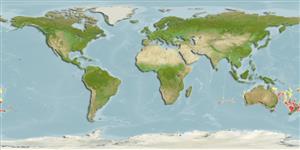Teleostei (teleosts) >
Gadiformes (Cods) >
Macrouridae (Grenadiers or rattails)
Etymology: Trachonurus: Greek, trachon, -onos = roughness + Greek, oura = tail (Ref. 45335); gagates: Named in reference to the dark scale covering of the body..
More on authors: Iwamoto & McMillan.
Environment: milieu / climate zone / depth range / distribution range
Ecology
Marine; bathydemersal; depth range 436 - 1240 m (Ref. 13675). Deep-water; 15°S - 44°S
Western Pacific: Australia and New Zealand.
Size / Weight / Age
Maturity: Lm ? range ? - ? cm
Max length : 47.8 cm TL male/unsexed; (Ref. 13675)
Short description
Morphology | Morphometrics
Dorsal
spines
(total): 2;
Dorsal
soft rays
(total): 6-8. Without a grooved lateral line. Chin barbel 4-8 % of head length. Suborbital width, 13-15%; postorbital length of head 50-55%. Total gill rakers of first arch (mesial) 11-13; second arch (lateral or mesial) 10-13/10-12. Scale rows below mid-base of first dorsal 25-31; over a distance equal to predorsal length usually 35-42; and between pelvic fin base and gill cover 11-14. Mouth moderately large; lips thick and fleshy (Ref. 13675).
A benthic species found on the continental slope (Ref. 75154).
Life cycle and mating behavior
Maturity | Reproduction | Spawning | Eggs | Fecundity | Larvae
Iwamoto, T. and P. McMillan, 1997. A new grenadier , genus Trachonurus, from New Zealand and Australia (Pisces: Gadiformes: Macrouridae). Mem. Mus. Victoria 56(1):255-259. (Ref. 13675)
IUCN Red List Status (Ref. 130435)
Threat to humans
Harmless
Human uses
More information
Common namesSynonymsMetabolismPredatorsEcotoxicologyReproductionMaturitySpawningSpawning aggregationFecundityEggsEgg development
Age/SizeGrowthLength-weightLength-lengthLength-frequenciesMorphometricsMorphologyLarvaeLarval dynamicsRecruitmentAbundanceBRUVS
ReferencesAquacultureAquaculture profileStrainsGeneticsElectrophoresesHeritabilityDiseasesProcessingNutrientsMass conversion
Tools
Special reports
Download XML
Internet sources
Estimates based on models
Preferred temperature (Ref.
123201): 5.7 - 9, mean 7.8 °C (based on 107 cells).
Phylogenetic diversity index (Ref.
82804): PD
50 = 0.5156 [Uniqueness, from 0.5 = low to 2.0 = high].
Bayesian length-weight: a=0.00219 (0.00111 - 0.00431), b=3.20 (3.03 - 3.37), in cm total length, based on LWR estimates for this (Sub)family-body shape (Ref.
93245).
Trophic level (Ref.
69278): 3.6 ±0.5 se; based on size and trophs of closest relatives
Resilience (Ref.
120179): Very Low, minimum population doubling time more than 14 years (Preliminary K or Fecundity.).
Fishing Vulnerability (Ref.
59153): Moderate vulnerability (38 of 100).
